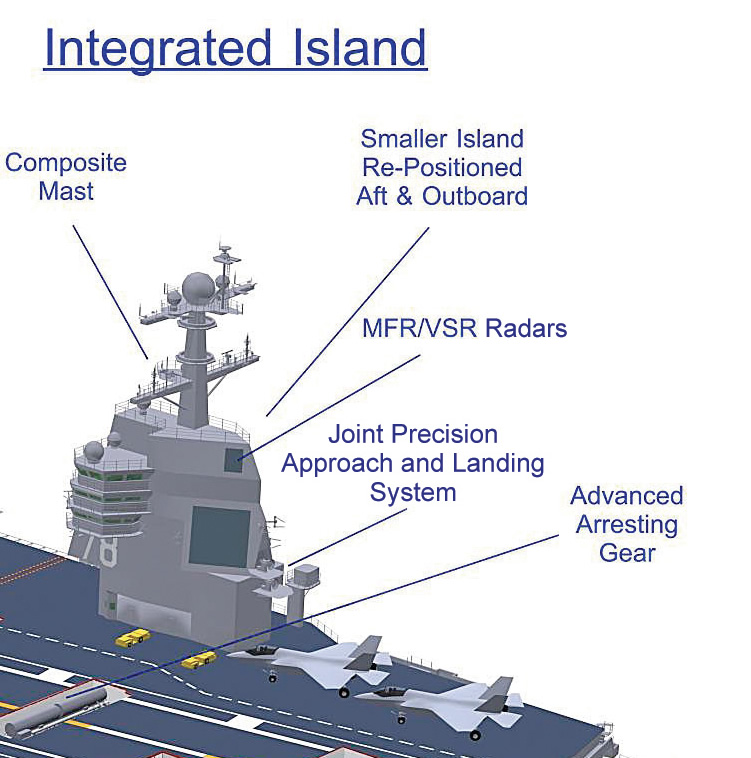Raytheon Co., Integrated Defense Systems, Tewksbury, Massachusetts, is being awarded a $26,917,593 cost-plus-fixed-fee design agent contract to provide level-of-effort support for the development environment infrastructure that supports the complete development, verification and support of the CVN 78 Dual Band Radar (DBR) and support of testing to be accomplished at Wallops Island Engineering Test Center Land Based Test Site.
This radar suite is a single, integrated radar system combining the AN/SPY-3 Multi-Function Radar at X-Band and AN/SPY-4 Volume Search Radar at S-Band. This radar suite is a state of the art, high performance radar system with self-defense anti-aircraft warfare mission. The design agent contract described is intended to provide the engineering services necessary to fully mitigate numerous system integration schedule risks that are being tracked by the DBR program. This contract will provide services necessary to conduct follow on software interface development efforts to resolve software trouble reports discovered during land based and at-sea testing.
This contract includes options which, if exercised, would bring the cumulative value of this contract to $50,821,247. Work will be performed in
- Sudbury, Massachusetts (86 percent);
- Moorestown, New Jersey (9 percent); and
- Burlington, Massachusetts (5 percent),
and is expected to be completed by December 2015. Fiscal 2015 shipbuilding and conversion (Navy) and fiscal 2015 research, development, test and evaluation funding in the amount of $11,602,288 will be obligated at the time of contract award and will not expire at the end of the current fiscal year. This contract was not competitively procured in accordance with authority FAR 6.302-1(a)(2)(iii) - only one responsible source and no other supplies or services will satisfy agency requirements. The Naval Sea Systems Command, Washington, District of Columbia, is the contracting activity (N00024-15-C-5335).
Related/Background
- SCANFAR. The first time the Navy used fixed aperture phased array radars was the AN/SPS-32/33 developed by Hughes Aircraft GSG (later purchased by Raytheon after being owned by GM) for two unique vessels: the CVN-65 USS Enterprise and the CGN-9 USS Long Beach. This phased array radar system was known as SCANFAR. SCANFAR was intended to be better at tracking multiple airborne targets than conventional rotating antenna radars. The AN/SPS-32 was a long-range air search and target acquisition radar. The AN/SPS-32 operated together with the AN/SPS-33, which was the square array used for 3D tracking, into one system. It placed a massive power drain on the ship's electric system. The technology of the AN/SPS-32 was based on vacuum tubes and the system required constant repairs. The SPS-32 was a phased array radar which had a range of 400 nautical miles against large targets, and 200 nautical miles against small, fighter-size targets. These early phased arrays, replaced around 1980, were responsible for the distinctive square-looking island. The AN/SPS-32 and AN/SPS-33 radars, while ahead of their time, suffered from issues relating to electrical beam steering mechanism and were not pursued in further ship classes. To some extent, they were replaced by the AN/SPS-48E which used frequency scanning in the vertical and mechanical azimuth rotation. While they are considered to be an early form of "phased array" radar, they were ahead of their time and it would take the later technology of the Aegis phased array AN/SPY-1 with its electronically controlled beam steering to make phased array radars both reliable and practical for the USN.
- Dual Band Radar Swapped Out In New Carriers - In something of a surprise move, the US Navy revealed the long-touted dual band radar (DBR) being installed in new carriers of the Gerald R. Ford class will only be fitted on the first ship, and a new, yet-to-be-chosen radar will be installed on subsequent ships.

_CVN-65_Enterprise_1962-02-10.jpg)
No comments:
Post a Comment